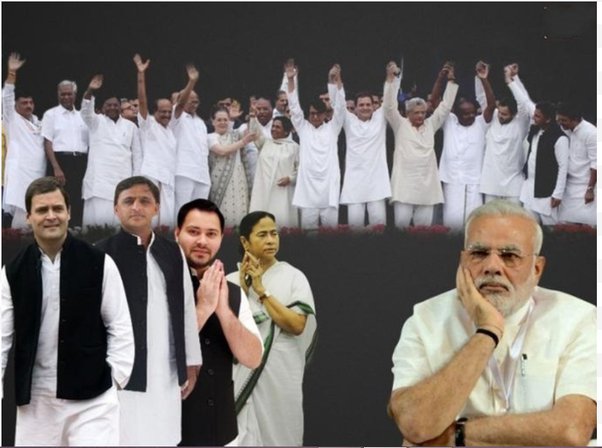By Rajan Narayan
Modi rose to power in the 2014 elections and has had a stranglehold on the government ever since. Now, the opposition political leaders of the nation are banding together to present a united front for 2024 elections.
IT IS commendable that as many as 80 Opposition political party leaders have come together to take on Narendra Modi in the forthcoming parliamentary 2024 election. The sheer diversity of our regional parties dramatizes the opposition to the Modi government and its political agenda. The Opposition leaders of the Indian National Developmental Inclusive Alliance (INDIA) include the Chief Minister of Tamil Nadu MK Stalin, the Chief Minister of West Bengal Mamata Banerjee, the Chief Minister of Bihar Nitish Kumar, the Chief Minister of Telangana K Chandrashekar Rao and others to indicate the extent of the opposition to Narendra Modi.
Besides the chief ministers, senior leaders and presidents of various parties also attended the recent conclave of the INDIA block in Mumbai over September 1 and 2, 2023. This includes the president of the Congress party, Mallikarjun Kharge, the dynasty representative of Sonia Gandhi and Rahul Gandhi, the Shiv Sena chief Uddhav Thackeray and master broker Sharad Pawar of the NCP.
Generally speaking politicians of the same party even within a state are not united. As demonstrated in Karnataka where senior Congress leaders fought for the chief minister’s post. In Maharashtra both the NCP and the Shiv Sena have split. There is a fight for leadership in Congress-ruled Rajasthan. In spite of all the discord Opposition leaders seem to be united in their opposition to a third term for Narendra Modi.
Needless to say it was an amusing and pleasant surprise, to see all the rival Opposition leaders seating together at the Oberoi Hotel in Mumbai where the grand conclave of INDIA was held. Not only did the 80 plus leaders get together, they even made progress in forming a strategy to contest the 2024 elections jointly. There will be only one candidate from each of the INDIA partnership. This will avoid a split in the vote.
SPLITTING VOTES
IT may be recollected that the BJP won the last parliamentary election by splitting the votes of opposition parties. The INDIA conclave has created a coordination committee. It has also constituted separate committees for the print, electronic and digital social research media. It has agreed to have a state-wide selection of candidates. They have wisely avoided the issue of leadership. There are many contenders for the prime minister’s post if team INDIA manages to defeat Narendra Modi and get a majority in the 2024 elections.
The Congress is still one of the largest political parties in India, currently. This does not necessarily mean that Rahul Gandhi will become the prime minister as regional party leaders Mamata Banerjee and MK Stalin are leading contenders for the prime minister’s post. There is also Bihar CM Nitish Kumar waiting in the wings. Even if the Congress emerges as a largest single party the other parties may not support Rahul for prime minister’s post.
WHO WILL BE KING MAKER?
THE big question is the role of Sharad Pawar. Will the Nationalist Congress party’s Sharad Pawar be satisfied to be the kingmaker or will he want to be the king himself? Sharad Pawar’s image has suffered because of the split in the NCP in which nephew Ajit Pawar joined the BJP. Yet there is no other leader yet with the negotiating skills of Sharad Pawar. Like a good chess player Sharad Pawar knows that sometime the queen has to be sacrifice for a pawn.
Of all the senior leaders of the INDIA group, perhaps the most acceptable for the prime minister’s post would be in fact, Sharad Pawar. There would be strong objections to Mamata Banerjee who is totally identified with West Bengal. Similarly, the regional roots of Stalin may be an obstacle. Nitish Kumar is a promising candidate. Moreover, he represents one of the biggest states in the country, Bihar.
Finally who will be crowned king will depend on how many seats each party wins. Tamil Nadu and West Bengal have a largest number of parliamentary seats with BJP in a minority at least in these states. It is significant to note that even in the last parliamentary elections percentage wise the joint opposition got more votes than the BJP.
The BJP is beatable. Arvind Kejriwal showed that the BJP can be defeated not only in Delhi but in Punjab. The southern states have no sympathy for the BJP. Karnataka which has been captured by the BJP has been returned to the Congress. The entire south is against the BJP. What will make the big difference is INDIA fares in Uttar Pradesh which has 80 parliamentary seats. This may be offset by the performance of INDIA in Bihar and Maharashtra which carry a large number of parliamentary seats.
GOA INSIGNIFICANT
GOA of course does not matter because it has only two seats in the Lok Sabha and one in the Rajya Sabha, of the three seats the North Goa parliamentary seat and the Rajya Sabha seats are with the BJP, while Francisco Sardinha of the Congress party is the South Goan Member of Parliament. The reason why the BJP is supporting the diversion of the Mhadei river water is because Karnataka has a much larger number of Lok Sabha seats.
Significantly, voters do not vote for the same party in their own state and in the parliamentary elections. Who they vote for in the parliamentary elections depends on who is projected as the leader for potential prime minister after a parliamentary poll. The BJP has created a confusion by calling for a special session of parliament in late September to discuss the idea of common election for the states. This could upset the plans of the Opposition leaders and their parties. However, it will save a lot of money as with elections every month in some state or other wastes a lot of money.
